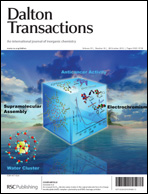A cyclometalation reaction involving C–F bond activation at a cobalt(I) center with an aldazine-N atom as anchoring group affords ortho-chelated cobalt(III) complexes containing a [C–Co–F] fragment [CoFMe(PMe3)2{(C6H3F-ortho)CH![[double bond, length as m-dash]](https://www.rsc.org/images/entities/char_e001.gif) N–R}] 5–8. Under similar reaction conditions π-coordinated cobalt(0) complexes [Co(PMe3)3((C6H3F-ortho)CH
N–R}] 5–8. Under similar reaction conditions π-coordinated cobalt(0) complexes [Co(PMe3)3((C6H3F-ortho)CH![[double bond, length as m-dash]](https://www.rsc.org/images/entities/char_e001.gif) N–R)] 12–14 were formed when [Co(PMe3)4], instead of [CoMe(PMe3)4], was applied. C–F bond activation did not occur. Carbonylation of complexes 6–8 delivered novel organic fluorides 15–17. A proposed formation mechanism of the novel organic fluorides with demetallation and carbonylation of complexes 6–8 by CO is discussed with experimental support. As important intermediates, an acetyl cobalt complex, [CoFMeC
N–R)] 12–14 were formed when [Co(PMe3)4], instead of [CoMe(PMe3)4], was applied. C–F bond activation did not occur. Carbonylation of complexes 6–8 delivered novel organic fluorides 15–17. A proposed formation mechanism of the novel organic fluorides with demetallation and carbonylation of complexes 6–8 by CO is discussed with experimental support. As important intermediates, an acetyl cobalt complex, [CoFMeC![[double bond, length as m-dash]](https://www.rsc.org/images/entities/char_e001.gif) O(PMe3)2{(C6H3F-ortho)CH
O(PMe3)2{(C6H3F-ortho)CH![[double bond, length as m-dash]](https://www.rsc.org/images/entities/char_e001.gif) N–R}] 20, and a 19-electron cobalt(0) complex, Co(CO)3(PMe3)221, were structurally characterized. The crystal and molecular structures of complexes 5, 6, 8, 12, 20 and 21 were determined by X-ray diffraction.
N–R}] 20, and a 19-electron cobalt(0) complex, Co(CO)3(PMe3)221, were structurally characterized. The crystal and molecular structures of complexes 5, 6, 8, 12, 20 and 21 were determined by X-ray diffraction.
You have access to this article
 Please wait while we load your content...
Something went wrong. Try again?
Please wait while we load your content...
Something went wrong. Try again?
![[double bond, length as m-dash]](https://www.rsc.org/images/entities/char_e001.gif) N–R}] 5–8. Under similar reaction conditions π-coordinated
N–R}] 5–8. Under similar reaction conditions π-coordinated ![[double bond, length as m-dash]](https://www.rsc.org/images/entities/char_e001.gif) N–R)] 12–14 were formed when [
N–R)] 12–14 were formed when [![[double bond, length as m-dash]](https://www.rsc.org/images/entities/char_e001.gif) O(PMe3)2{(C6H3F-ortho)CH
O(PMe3)2{(C6H3F-ortho)CH![[double bond, length as m-dash]](https://www.rsc.org/images/entities/char_e001.gif) N–R}] 20, and a 19-electron
N–R}] 20, and a 19-electron 

 Please wait while we load your content...
Please wait while we load your content...